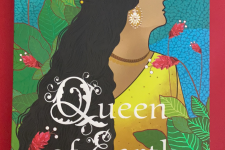Title: 10 Indian Traditions of Folk Music That Tell Our Stories
Written by: Mamta Nainy
Cover design: Gina James
Published by: Duckbill (an imprint of Penguin Random House)
Length: 152 pages
Type: Paperback
Age recommendation: 10 years and above
The’10’s’ series from Duckbill explores the fascinating world of Indian art and culture. I had the honour of receiving and reviewing the ’10 Indian Traditions of Folk Music That Tell Our Stories’ by Mamta Nainy and I was blown away by the sheer creativity and richness of our country’s musical forms.
Mamta Nainy focuses on the history behind each music form: tracing its origin and following its creative trajectory through the region’s cultural evolution. The book takes us on a musical sojourn across the length and breadth of India as we learn about the lesser known musical art forms of our country. She also showcases an exponent of each particular music form: an individual who popularized or preserved the art form.
The author also mentions about indigenous musical instruments which form accompaniments to each music form: the libuh & khrokhro of Li music (Nagaland); dhol, surnai and nagara of bhand pather (Kashmir).
Why a book on folk music you wonder? Well, it’s more than just about the songs. Folk songs capture the essence and emotions of the heartlands, often chronicling the culture of the regions. It gave a voice to the otherwise ‘voiceless’ sections of the society who could express their feelings. Special songs to commemorate significant life events, seasons or festivals are passed down through generations. Topics of cultural and religious significance would be set to song.
Our journey starts with the Bidesia music of Bihar. These are Bhojpuri folk songs which capture the angst and homesickness of migrant Bihari workers. In the early 19th century, the British used indentured cheap physical labour (mainly from politically unstable and famine-ridden Uttar Pradesh and Bihar) for their plantations in distant lands. Impoverished Indians who migrated in search of better life struggled in foreign lands. Music helped them remember their loved ones and gave voice to their anguish.
We are introduced to the Gatha and Katha of the migrant Manganiyar-Langa community of Rajasthan. These ballads sing of Rajputana princes, brave warriors and star-crossed lovers. With an interesting story tracing the origins of the Manganiyar all the way back to the birth of Prophet Mohammed’s grandsons, this incredibly talented musical community has their unique musical instruments have received global recognition (the bejeweled window box comes to mind!).
The Ladishahs of Kashmir were itinerant bards who would sing about cultural and political topics. We are introduced to Bhand Pathers: a performing troupe whose acts included comedy and satire and were called “remover of sorrows”. The partition and the militancy almost wiped out the Ladishahs from Kashmir. Will the Kashmiri youngsters be able to revive this centuries-old performance artform? Read the book to find out!
The Nizami Qawwalis refer to the soulful performances sung at the dargahs of Sufi saints. We learn about how Sufi saints, under the Mughal patronage, introduced the qawwali performances. Do you which city is the spiritual capital of Indian sufism and is also called “Bais Khwajaaon ki Chaukat”? The tradition has been passed down orally for almost 700 years! Qawwalis eventually moved from spiritual dargahs to silver screens.
We learn about the Pandavani (songs of Pandavas) folk music of Chhattisgarh whose origins can be traced to the Gond community. This art blended local Gond stories and characters into the well- known epic Mahabharata.
It was amazing to learn how the Mahabharata written in Sanskrit was adapted by numerous communities and tribes across the country – infusing local flavour and weaving in cultural references to make Veda Vyasa’s epic more relatable.
Folk music played an instrumental role in the integration of the marginalised castes into the society. One such example is of the Vankar weaver community of Kutch. They sing Kabir’s songs during weaving. Saint Kabir’s songs compare divine creations to a finely woven shawl, thereby “using weaving metaphors to simplify life’s complex philosophies”.
The Jogappas of Karnataka are a lesser-known transgender community who dedicate their lives to the worship and service of a Goddess Renuka Yellamma. Singing Janapadas (bhajans) in Kannada, Marathi and Telugu, this community sings about the Goddess defeating patriarchy. They play unique instruments called chowdki – a rare percussion instrument. We learn of Padma Shri recipient, Mamjamma Jogathi, a Jogamma exponent who popularized the dance form.
The Lavani Folk Music of Maharashtra is known for its foot-tapping hypnotic music with the dancers draped in nauvari saris. The graceful dancers used to perform in baithaks. The performances grew in popularity during the Peshwa rule with the Lavani dancers performing for the soldiers. Did you know that kala kendras flourish even today in Maharashtra, as Lavani is performed for select private audiences?
The author has wonderfully analysed how each art form was deeply impacted by social and caste constraints. She has delved into how and why the marginalisation of particular art forms has occurred.
Next, we reach the North eastern part of India and learn about the Li music of the Chakhesang Nagar tribe. The Li music speaks of political and social issues, uniting the community during their farming practices. I was particularly fascinated by how musically complex and layered Li is! The pitch and tempo of the songs vary not just up and down, but even side ways!
At last we end with the Bhatiyali music of Bengal, whose form is linked to the riverside. Numerous rivers traverse Bengal which led to the boatmen (majhis) to come up with songs. It was amazing to learn how different the Bhatiyali songs were from the other typical folk art forms. These songs would ponder on philosophical issues.
The book left me in reeling under a myriad of emotions: awe and pride at the sheer musical prowess of our country; sheer admiration for the numerous resilient folk artists who have fought social stigma and overcome economic hurdles to preserve an art form. One realises how many folks artists and their dying art forms still need encouragement and financial support to become popular in the mainstream society.
What really stood apart for me, is the meticulously compiled detailed listening list at the end of each chapter with YouTube links to the particular genre of music. Afterall, good music deserves ears!
My 4 year old was absolutely mesmerized by some of the musical performances we saw on YouTube, particularly the soothing qawwali (‘Kun Faaya Kun’ from Rockstar) and the foot-tapping Lavani numbers.
I just wish the text could have been complimented with a few illustrations. I feel it would have further enriched the pages of a book on art.
So before you command Alexa to play your favourite tunes, I invite you to pick up this book to discover Indian folk music and be prepared to be transported to the magical world of music. Who knows, you (and your kiddo) may need to update your Spotify playlist with a few Indian folk songs!
Other books in this series (the 10s):
10 Indian Champions Who Are Fighting to Save the Planet by Bijal Vachharajani
10 Indian Women Who Were the First to Do What They Did by Shruthi Rao
10 Indian Animals You May Never Again See in the Wild by Ranjit Lal
10 Indian Monarchs Whose Amazing Stories You May Not Know by Devika Rangachari
10 Indian Heroes Who Help People Live With Dignity by Sonak Ghoshal
10 Indian Tribes and the Unique Lives They Lead by Nidhi Dugar Kundalia
10 Indian Scientists Whose Extraordinary Work You May Not Know by Vaishali Shroff
NEW BOXSET- MAKES AN EXCELLENT GIFT! Six 10s: Sixty Indian Stories You May Not Have Heard Before Box Set
If you enjoyed this musical review and wish to order the book from Amazon (kbc affiliate link),
CLICK & BUY NOW!Disclaimer: Sowmya is a part of the #kbcReviewerSquad and received this book as a review copy from the publisher via kbc.

![A Folk Musical Sojourn Across India [Review]](https://www.kidsbookcafe.com/wp-content/uploads/2025/04/10-indian-traditions-of-folk-music-cover.jpg)




